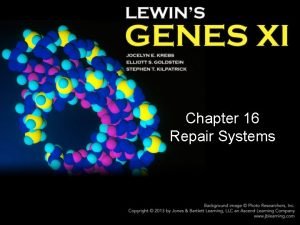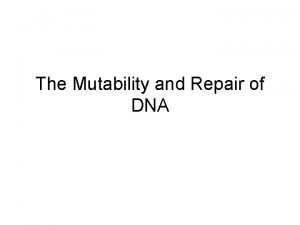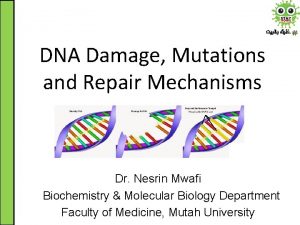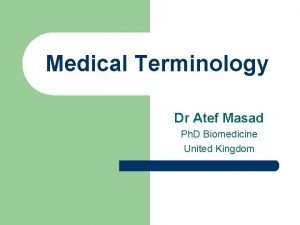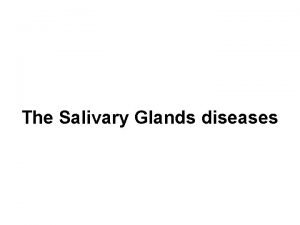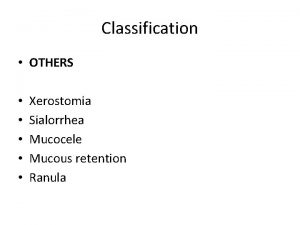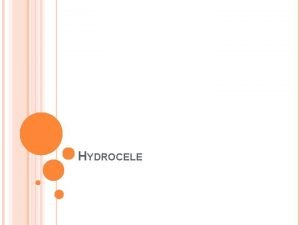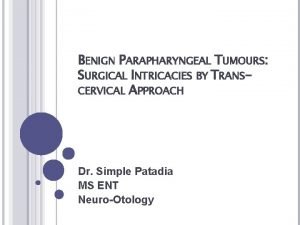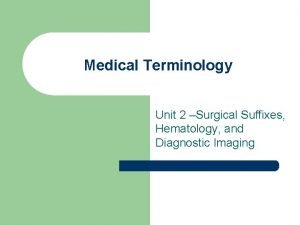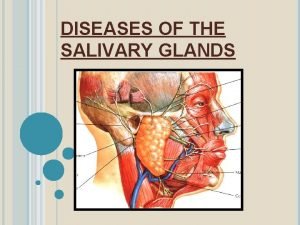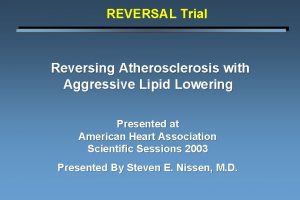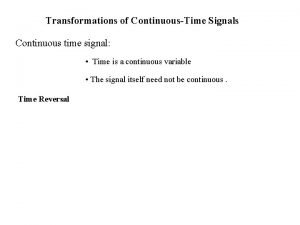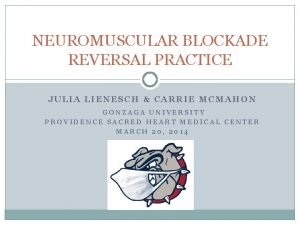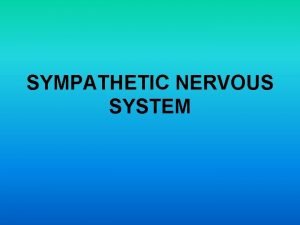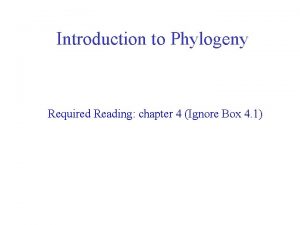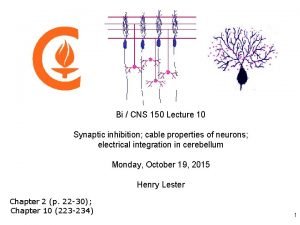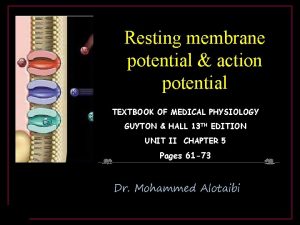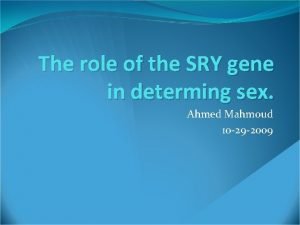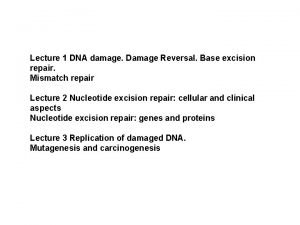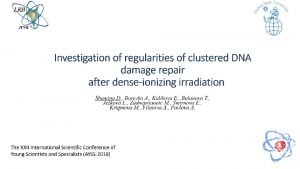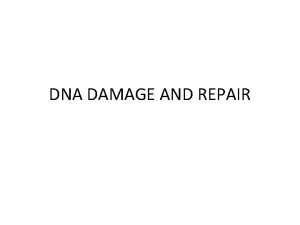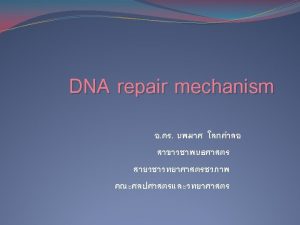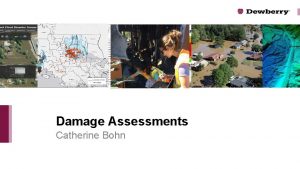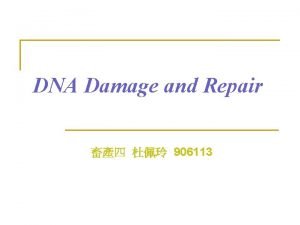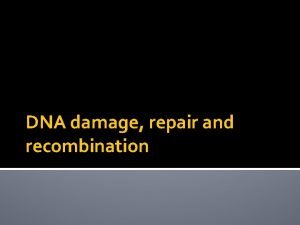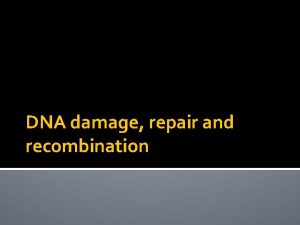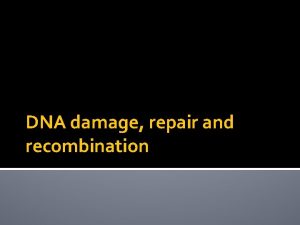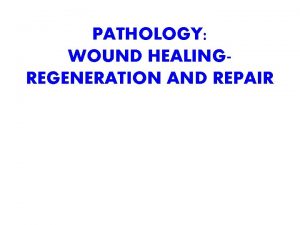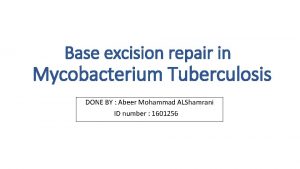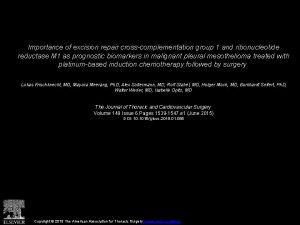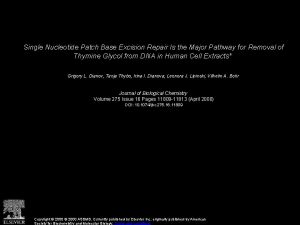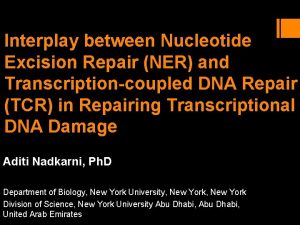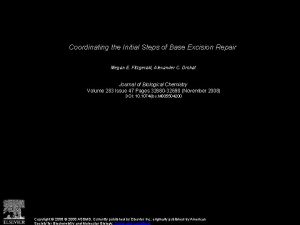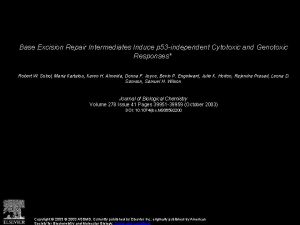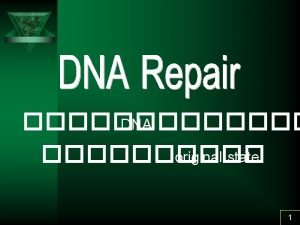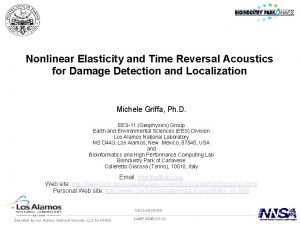Repair mechanisms 1 Reversal of damage 2 Excision


























- Slides: 26

Repair mechanisms 1. Reversal of damage 2. Excision repair 3. Mismatch repair 4. Recombination repair 5. Error-prone repair 6. Restriction-modification systems

1. Reversal of damage • Enzymatically un-do the damage • a) Photoreactivation • b) Removal of methyl groups

Photolyase breaks apart pyrimidine dimers 5 6 d-ribose Photolyase breaks the bonds between the d. Ts

1 a. Photoreactivation • Photolyase: binds a pyrimidine dimers and catalyzes a photochemical reaction • Breaks the cyclobutane ring and reforms two adjacent T’s • 2 subunits, encoded by phr. A and phr. B.

2. Excision repair • General Process: – remove damage (base or DNA backbone) – ss nick/gap provides 3’OH for DNA Pol I initiation – DNA ligase seals nick • Nucleotide excision repair: – Cut out a segment of DNA around a damaged base. • Base excision repair: – Cut out the base, then cut next to the apurinic/apyrimidinic site, and let DNA Pol I repair

Discovery of mutants defective in DNA repair uvr -

pol. A mutants are defective in repair wt pol. A mutant DNA synthesis in vitro Survival after UV in vivo

Uvr. ABC excision repair

Cleavage and helicase

Fill in with polymerase and ligate

Mutations in excision repair in eukaryotes can cause xeroderma pigmentosum (XP) Human Gene XPA XPB XPC XPD XPE XPF XPG Protein Function Binds damaged DNA Helicase, Component of TFIIH DNA damage sensor Helicase, Component of TFIIH Binds damaged DNA Works with ERRCI to cut DNA Cuts DNA Analogous to E. coli: Uvr. A/Uvr. B Uvr. D Uvr. A/Uvr. B/Uvr. C

2 b. Base excision repair Incorrect or

Excision and filling in by DNA Pol. I

3. Mismatch repair • Action of DNA polymerase III (including proofreading exonuclease) results in 1 misincorporation per 108 bases synthesized. • Mismatch repair reduces this rate to 1 change in every 1010 or 1011 bases. • Recognize mispaired bases in DNA, e. g. GT or A-C base pairs • These do not cause large distortions in the helix: the mismatch repair system apparently reads the sequence of bases in the DNA.

Role of methylation in discriminating parental and progeny strands • dam methylase acts on the A of GATC (note that this sequence is symmetical or pseudopalindromic). • Methylation is delayed for several minutes after replication. • Mismatch repair works on the un-methylated strand (which is newly replicated) so that replication errors are removed preferentially.

Action of Mut. S, Mut. L, Mut. H • Mut. S: recognizes the mismatch (heteroduplex) • Mut. L: a dimer; in presence of ATP, binds to Mut. S-heteroduplex complex to activate Mut. H • Mut. H: endonuclease that cleaves 5' to the G in an unmethylated GATC, leaves a nick

Mut. H, L, S action in mismatch repair #1

Mut. H, L, S action in mismatch repair #2

Mismatch repair: Excision of the misincorporated nucleotide

Eukaryotic homologs in mismatch repair • Human homologs to mut. L (h. MLH 1) and mut. S (h. MSH 2, h. MSH 1) have been discovered, because. . . • Mutations in them can cause one of the most common hereditary cancers, hereditary nonpolyposis colon cancer (HNPCC).

4. Recombination repair: retrieval of information from a homologous chromosome

5. Error-prone repair • Last resort for DNA repair, e. g when repair has not occurred prior to replication. How does the polymerase copy across a non-pairing, mutated base, or an apyrimidinic/apurinic site? – DNA polymerase III usually dissociates at a nick or a lesion. – But replication can occur past these lesions, especially during the SOS reponse ("Save Our Ship"). • This translesion synthesis incorporates random nucleotides, so they are almost always mutations (3/4 times)

Role of umu. C and umu. D genes in error-prone repair • Named for the UV nonmutable phenotype of mutants with defects in these genes. • Needed for bypass synthesis; mechanism is under investigation. E. g. these proteins may reduce the template requirement for the polymerase. • Umu. D protein is proteolytically activated by Lex. A.

Umu. C, Umu. D in error-prone repair UV damage DNA replication DNA Pol III Umu. D 2 Umu. C beta UV damage, increase Rec. A: ss. DNA Activate protease Induce umu. C+, umu. D+ epsilon DNA damage checkpoint control Graham Walker Translesional synthesis (error-prone) Umu. D’ 2 Umu. C Pol III alpha Polymerase for translesional synthesis

SOS response is controlled by Lex. A and Rec. A

Lex. A, Rec. A in the SOS response
 Dna repair mechanism notes
Dna repair mechanism notes Mismatch repair
Mismatch repair Base analogs
Base analogs Cyclobutane thymine dimer
Cyclobutane thymine dimer Clasis a suffix denoting break, fracture
Clasis a suffix denoting break, fracture Basal cell adenoma
Basal cell adenoma Submandibular gland excision
Submandibular gland excision Lords and jaboulay procedure
Lords and jaboulay procedure Submandibular gland excision
Submandibular gland excision Submandibular gland excision
Submandibular gland excision Dr dahla
Dr dahla Ectomy a suffix denoting an excision or removal
Ectomy a suffix denoting an excision or removal Frill evisceration
Frill evisceration Minor salivary glands
Minor salivary glands Reversal trial
Reversal trial Signal reversal
Signal reversal Holodiastolic flow reversal
Holodiastolic flow reversal Neostigmine atropine reversal
Neostigmine atropine reversal Vasomotor reversal of dale
Vasomotor reversal of dale Plesiomorphic vs apomorphic
Plesiomorphic vs apomorphic Divorce poem
Divorce poem Figure ground ambiguity examples
Figure ground ambiguity examples Reversal potential
Reversal potential Ec2314 digital signal processing
Ec2314 digital signal processing Reversal potential
Reversal potential Reversal of dwarfism is caused by which hormone
Reversal of dwarfism is caused by which hormone Sex reversal syndrome
Sex reversal syndrome

